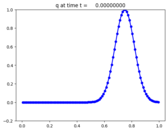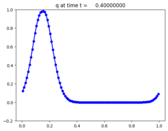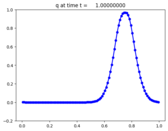#!/usr/bin/env python
# encoding: utf-8
r"""
One-dimensional advection
=========================
Solve the linear advection equation:
.. math::
q_t + u q_x = 0.
Here q is the density of some conserved quantity and u is the velocity.
The initial condition is a Gaussian and the boundary conditions are periodic.
The final solution is identical to the initial data because the wave has
crossed the domain exactly once.
"""
import numpy as np
from clawpack import riemann
def setup(nx=400, kernel_language='Python', use_petsc=False, solver_type='classic', weno_order=5,
time_integrator='SSP104', outdir='./_output'):
if use_petsc:
import clawpack.petclaw as pyclaw
else:
from clawpack import pyclaw
if kernel_language == 'Fortran':
riemann_solver = riemann.advection_1D
elif kernel_language == 'Python':
riemann_solver = riemann.advection_1D_py.advection_1D
if solver_type=='classic':
solver = pyclaw.ClawSolver1D(riemann_solver)
elif solver_type=='sharpclaw':
solver = pyclaw.SharpClawSolver1D(riemann_solver)
solver.weno_order = weno_order
solver.time_integrator = time_integrator
if time_integrator == 'SSPLMMk3':
solver.lmm_steps = 5
solver.check_lmm_cond = True
else: raise Exception('Unrecognized value of solver_type.')
solver.kernel_language = kernel_language
solver.bc_lower[0] = pyclaw.BC.periodic
solver.bc_upper[0] = pyclaw.BC.periodic
x = pyclaw.Dimension(0.0,1.0,nx,name='x')
domain = pyclaw.Domain(x)
state = pyclaw.State(domain,solver.num_eqn)
state.problem_data['u'] = 1. # Advection velocity
# Initial data
xc = state.grid.x.centers
beta = 100; gamma = 0; x0 = 0.75
state.q[0,:] = np.exp(-beta * (xc-x0)**2) * np.cos(gamma * (xc - x0))
claw = pyclaw.Controller()
claw.keep_copy = True
claw.solution = pyclaw.Solution(state,domain)
claw.solver = solver
if outdir is not None:
claw.outdir = outdir
else:
claw.output_format = None
claw.tfinal =1.0
claw.setplot = setplot
return claw
def setplot(plotdata):
"""
Plot solution using VisClaw.
"""
plotdata.clearfigures() # clear any old figures,axes,items data
plotfigure = plotdata.new_plotfigure(name='q', figno=1)
# Set up for axes in this figure:
plotaxes = plotfigure.new_plotaxes()
plotaxes.ylimits = [-.2,1.0]
plotaxes.title = 'q'
# Set up for item on these axes:
plotitem = plotaxes.new_plotitem(plot_type='1d_plot')
plotitem.plot_var = 0
plotitem.plotstyle = '-o'
plotitem.color = 'b'
plotitem.kwargs = {'linewidth':2,'markersize':5}
return plotdata
if __name__=="__main__":
from clawpack.pyclaw.util import run_app_from_main
output = run_app_from_main(setup,setplot)



